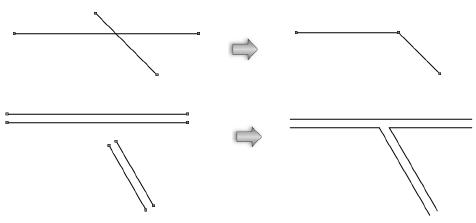
The Join command can be used to join two single lines, two double lines, or two walls together. Joined lines intersect but remain as individual objects.
Object |
Command |
Specifications |
Individual Lines |
Join Join (No Trim) |
An individual line can be joined to another individual line |
Double Lines |
Join Join and Fillet |
Double lines can be joined to another set of double lines or to a wall. Double lines drawn with the Create Polygons option (set in Double Line preferences) cannot be joined. Only the line elements of double lines drawn with the Create Lines and Polygons option can be joined. |
Walls |
Join Join (No Trim) |
A wall can be joined to another wall or to double lines created with the Create Lines option (set in Double Line preferences). Walls will join to the line elements of double lines drawn with the Create Lines and Polygons option. |
To join walls, single lines, or double lines:
Select the two non-parallel walls, lines, or double lines to join.
Select Modify > Join > Join.
The selected walls/lines are joined together with any excess trimmed away.

To join and fillet double lines:
Select the two sets of non-parallel double lines to join.
Select Modify > Join > Join and Fillet.
If a fillet measurement has already been specified for this drawing, the two double lines are connected and filleted using the default value.
If a fillet measurement has not yet been specified for this drawing, the Fillet Settings dialog box opens.
Enter the desired fillet radius and click OK to connect and fillet the lines.

The Fillet Settings dialog box is accessible from various locations in the Vectorworks program, whenever a fillet radius value can be set. A change to the radius value in one location changes the default setting in all locations.
To join two overlapping walls or individual lines, without trimming away the excess:
Select the two non-parallel walls or lines to join.
Select Modify > Join > Join (no trim).
The selected walls/lines are joined without trimming any excess.

